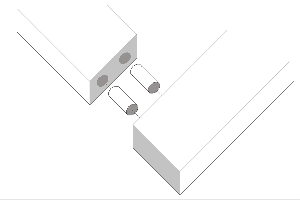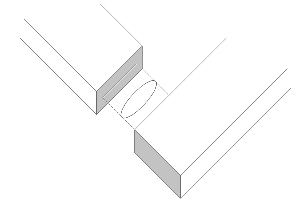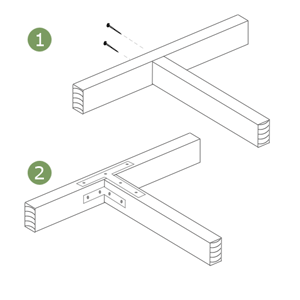Here we take a look at one of the most common joints used in woodworking, the simple but versatile Butt Joint. The butt joint is ideal for woodwork that will not be visible but can be used in almost any situation. The easiest method is the standard butt joint, but this can be strengthened by the introduction of dowels, biscuits (small ovals of wood) or simple metal brackets.
The type of butt joint you choose to make depends on time, skill and the tools available, but even with little experience and the most basic of tools, most people should be able to create a good basic joint for their projects.
What Are Butt Joints?
Probably the easiest type of joint, the butt joint is simply two pieces of wood butted together and then fixed into place. The grain on the end of the section that butts up against the side of the second section means that glue is not usually enough on its own to hold the two sections of wood in place.
Because of this, additional fixings must be used to add support. The simplest way to do this is to drive nails in at a slight angle to help clamp the two sections together (Fig 1). This type of butt joint is fine for basic cabinet making or a temporary framework, but there are more sturdy and elegant ways to create a butt joint.
Bracket or Plate Fixing Butt Joint
If the butt joint is going to be hidden from view, you can use a Right-angle or T-bracket to add strength to the joint (fig.2). These are thin, metal plates which are screwed into the wood and create a very firm joint. They do not look particularly nice, so are only suitable in hidden areas. You can also use a small triangle of plywood, screwed over the joint at the corners.
Screwed Joint
A very simple and strong type of butt joint. A screwed joint (fig. 1) is often seen as less aesthetically pleasing than a dowel or biscuit joint, but with a bit of extra work, the screw heads can easily be hidden. The screws should be at least twice as long as the thickness of the member they are passing through.
The screw holes can be countersunk to allow the screw heads to be sunk below the surface, or a counterbore can be used to create a deeper hole which can then be filled with a plug of wood or dowel. This can then be glued and sawn off flush to create an almost seamless finish.
Timber Blocks
You can add small timber blocks at the right angle of the joint to increase rigidity. These can be screwed into the main timber, or even glued with good-quality wood glue. You can also buy timber connectors which feature a row of small nails or teeth which are driven into the angle of the joint.
Dowel Reinforced Joints
If you have ever put a piece of flat-pack furniture, you have probably seen a dowel-reinforced butt joint. With flat-pack furniture, the holes for the dowels are pre-drilled, but if you are making the joints yourself, you will need to drill them yourself.

A device called a dowelling jig can help you in getting the holes accurately lined up (accuracy is essential with this type of joint). Drilling the holes slightly smaller than the diameter of the dowel you are using is important in getting a strong joint. Dowel-reinforced joints can simply be glued, but you can also drive a screw in through one member and into the end of the adjoining member to further increase strength.
Biscuit Reinforced Joints
Not as common as the dowel-reinforced joint, biscuit-reinforced joints are more commonly found in cabinet making and frame making. The biscuit in the name is a small oval of treated and dried wood which fits into a corresponding slot cut into the area of the butt joint.

Cutting the slots for the biscuit can be done with a special attachment for a router, but it is easier to use a tool called a biscuit joiner (these can be hired). Biscuit-reinforced joints are becoming increasingly popular as they require less accuracy and create a very strong joint. When the glue is applied to the biscuit and it is inserted into the rebate, the wood swells and increases the bond.
Knock-Down Fasteners
Knock-down fasteners usually consist of cam dowels locked by cam locks installed in adjacent members. The members are brought together and the joint is secured by turning the cam-lock. This type of fastener is very popular in flat-pack furniture and is designed to be assembled and unassembled several times.








